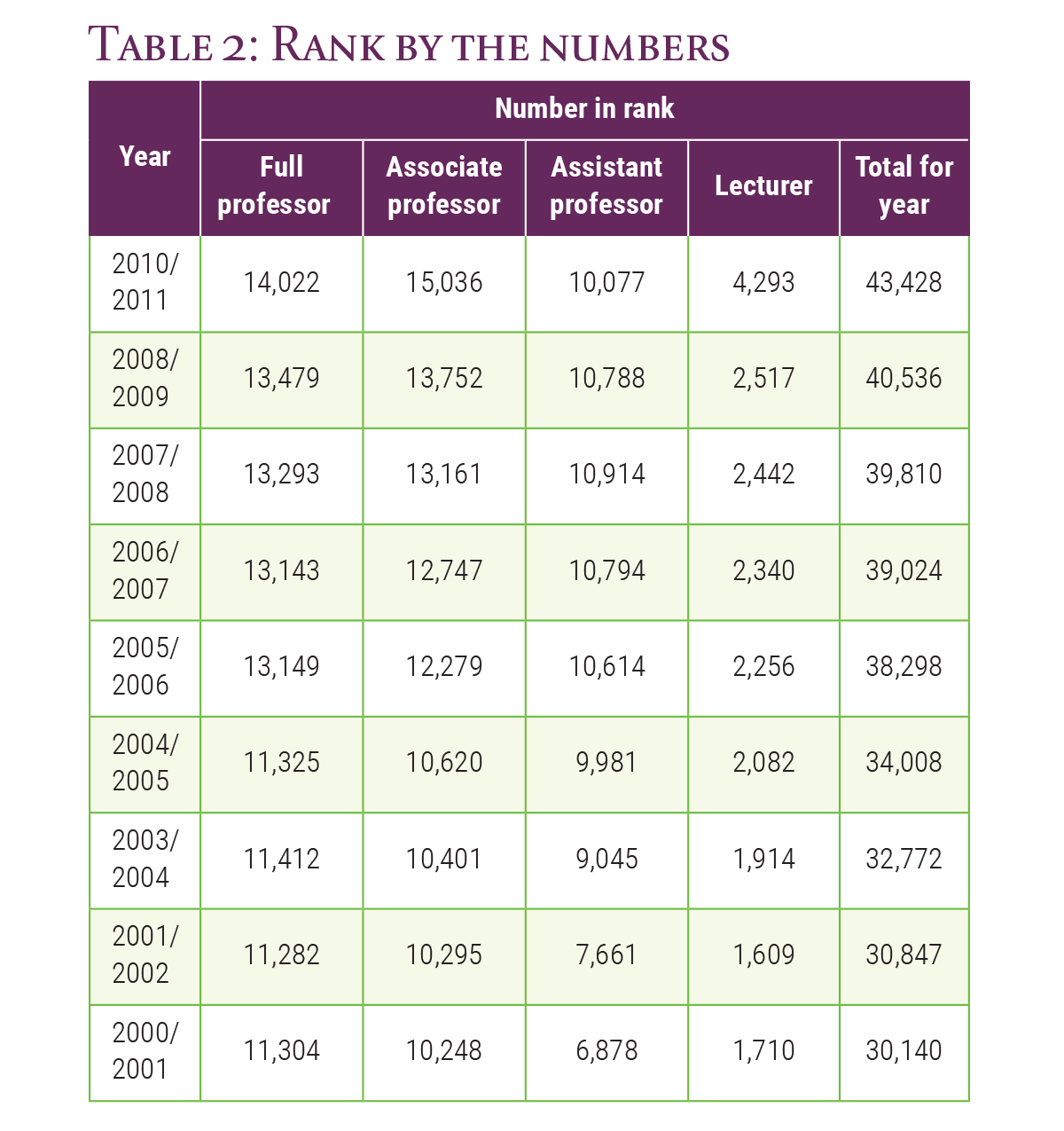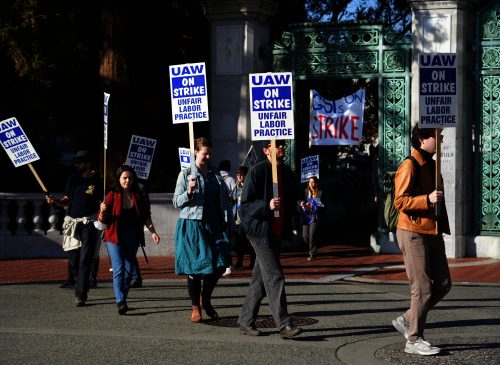How much can data meaningfully inform decisions about tenure? If data only tell part of the story, perhaps faculty should be evaluated so that their different lived experiences are also taken into consideration.

Tenure is one of the foundational concepts upon which Canada’s modern university system has been built. It is not without its issues, of course: Faculty often struggle in their early years as they work toward earning tenure.
How much can data-gathering inform tenure decisions? Or reflect the efforts and experiences of individuals who go through years of tenure-track in the hopes of meeting the expectations for tenure?
Data about tenure
Let’s begin by considering that there are data available about tenure—important and interesting data. One example is data from the CAUT Almanac of Post-Secondary Education in Canada (see Table 1), which provides quantitative details about the number of faculty with tenure, in tenure-track positions, and in other types of positions. The data are constrained by changes in government policy regarding the collection of the data and, to the best of our knowledge, more recent figures are not readily available. (While it is tangential to this article, when using data for evaluative purposes it is important to consider the possibility that data collection can be altered over time, causing the evaluative process to lose clarity.)

What Table 1 reveals is how rapidly faculty tenure numbers can change. The decline from 27,633 to 19,137 tenured faculty seen between 2006/2007 and 2007/2008 seems to defy the often suggested permanence of tenure. Similarly, the “Other” column values decline dramatically, from 11,361 to 3,822 between 2004/2005 and 2005/2006. These data allow us to evaluate the stability of faculty and confirm the “precarious” moniker used to describe university faculty. In that sense, data-gathering does facilitate some understanding of tenure.
Another collection of data, also from the CAUT Almanac, outlines the number of faculty within different ranks (see Table 2). It is often assumed that promotions hinge on tenure; however, the data clearly show that policies do allow promotion and tenure to be treated somewhat independently. Consider, for example, that in 2004/2005 there were 15,543 tenured faculty but 21,945 full and associate professors. This certainly allows one to conclude that university policies are not as simple as might be assumed. Over the decade covered by the table, the number of full professors increased by 24 per cent, associate professors and assistant professors both increased by 47 per cent, and lecturers by 151 per cent—demonstrating that growth has occurred and that it has favoured non-research faculty. While this category may include permanent faculty with no research requirement, it also includes sessional instructors, who hold the least permanent positions. Both undermine one of the core missions of the university: research. The data also reveal that new research faculty are embedded in a situation with proportionately fewer research mentoring options.

The stories the data do not tell
Although the data presented show various trends and phenomena, they do not, in and of themselves, provide information about tenure decision-making or the experiences of faculty members entering academia. Even if the CAUT Almanac analysis was done at the institutional level and by subject discipline, which is feasible, the information would not suffice. There should be skepticism about its value for informing individual faculty members or tenure and promotion committees about the process of achieving tenure.
Previously, we shared our concerns that evaluative data did not reflect personal decision-making or lived experiences. This led us to look for narratives about the meaning of tenure-track. We were both well established in public education, Tim as an experienced teacher and Tory in educational leadership, before moving to positions in higher education, giving up employment security to pursue tenure. In making that decision, it would have been helpful to have data showing the success rate of achieving tenure. This would have allowed us to make more informed decisions about moving to higher education and, perhaps, such data would illustrate just how precarious it is to pursue tenure. In addition, seeing a description of what goes wrong during tenure-track and what leads to failed attempts at achieving tenure would have allowed us to self-evaluate throughout the process. Instead, tenure-track faculty are given specious advice from colleagues in building corridors, rather than factual evaluative data.
Tenure-track faculty are given specious advice from colleagues in building corridors, rather than factual evaluative data.
It is these kinds of considerations that make one wonder if the control of data collection, and the choices about what data are collected, are being manipulated to avoid revealing or facilitating forms of evaluation that might lead to demands for changes to institutional systems and governance.
This is problematic. For instance, data could be collected that enumerate the number of publications in various categories between successful and unsuccessful applications by subject area, immediately reinforcing notions of tenure being based upon “bean-counting,” and therefore helping to diminish academic freedom. How can faculty be innovative and responsive to the dynamic nature of research if they are ultimately focused on tabulations in fixed categories to achieve tenure? Academic freedom addresses this by ensuring that professors can make choices best suited to the innovations arising from their research. Tenure cannot be measured in terms of static, quantitative achievements that defy the dynamic university environment that is supposed to facilitate innovation.

These considerations led us to develop a book about tenure-track experiences. The Academic Gateway: Understanding the Journey to Tenure1, brings together narratives of tenure-track experiences from across Canada. To make the task tractable, it focuses on faculty members in education, a discipline in which work experience as a teacher often informs the professorial role. This is not to suggest that other disciplines do not have overlap between careers and academia, only that education was viewed as sharing one meaningful overlap—teaching is 40 per cent of the assignment. In this way, we feel the narratives are likely more biased toward illustrating smoother transitions than might be found in other disciplines. However, they also demonstrate that there is a considerable diversity of experience.
The book includes authors from every province, and approximately equal numbers of academics who are early, midway, and late in the tenure-track process. As well, there is gender equity across the chapters. However, knowing all this about the book does not allow one to evaluate the experiences that arise within its chapters. These differences are reflected in the varied ways in which the authors entered higher education—for example, some worked while pursuing graduate school and others took time away from their careers—and the experiences they had after joining the academy. The chapters speak to how lived experiences can be much more illuminating than simple quantitative data. In essence, it is the recognition of the importance of these varied experiences that obliges the use of peer evaluation, rather than just data, to make decisions about tenure.
Consider the following quotes from The Academic Gateway that show a variety of faculty experiences and speak to very different circumstances when entering academia: “My wife and I left permanent education positions, financial security, and family networks in Alberta… as I was offered a one-year term position as an assistant professor… This was not a tenure-track appointment, but I was told it would turn into one.” Another writer speaks of the emotional strain of moving: “In my new surroundings—living alone for the first time in 29 years, feeling lost and lonely, and having left family and friends behind—I began to seriously doubt my ability to cope.” There are also changes in stature noted: “I am on a steep learning path. Transitioning from a position where I had designated authority to a position as a junior faculty member means I am negotiating and navigating the bounds of my role.” While a critical eye can point to these experiences and say that none are relevant to tenure considerations, they are evidence of the deep changes that moving into academia can have on different individuals. For example, the following quote describes a formal application within tenure-track and demonstrates issues with data-gathering and requiring applicants to conform to specific criteria:
This template featured categories and requirements entirely (and appropriately) geared to an academic career; but I found myself, for example, unable to list technical papers and publications I had written because policies in government had prohibited named authorship. This issue turned out to be the tip of the iceberg, as the methods, vocabulary, and rhetorical strategies I used to succeed in government did not transfer as readily as expected.
This issue may have become even more prevalent in recent decades, because graduate students tend to be older, taking longer to graduate as they work to pay for their education.
One difficulty that arises with data collection is that it does not recognize the fine details that are part of lived experiences. The absence of these details creates an environment in which academic supervision does not have to consider anything other than quantitative data. However, many authors in the book speak of circumstances in their lived tenure-track experience that needed a more nuanced analysis and a more personalized response in order to support their personal and professional growth. It is alarming to contrast the personal upheaval of moving into the academy with an impersonal, data-oriented approach that is oblivious to personal struggles.
One difficulty that arises with data collection is that it does not recognize the fine details that are part of lived experiences.
The narratives in the book speak to the human side of tenure-track. While some may favour a quantitative approach to tenure decisions, the book’s qualitative narratives are demonstrable evidence that this approach does not work. Innovative research is rarely clear-cut and frequently ill-defined, but here it speaks to the very core of what tenure is.
A model of tenure: Grief and self-determination
After the book was published, we continued thinking about tenure and about the book as a source of cross-case narratives. This led to a model of tenure that comprises two components. The first component addresses the change in workplace culture when one moves into a tenure-track position: You need to learn the ways of a new institution, a sense of isolation occurs, and a loss of community becomes apparent when individuals move long distances. We address these essentially as a grieving process that models the sense of loss associated with prior workplace colleagues, community familiarity, and a loss of capacity to efficiently address fairly routine tasks.
It appears that, as tenure-track progresses well for individuals, this grief component of the model runs its course. Every professor who is on track to earn tenure, or believes that they are, will overcome any and all of the concerns that led to inclusion of this grief component. Of course, in some cases, individuals simply do not manifest any grief. For example, a person who moves directly from graduate studies to a tenure-track position at the same institution might transition quite seamlessly. We have also hypothesized that when an individual perceives that their tenure-track is not progressing in a successful fashion, the grief will manifest itself in more pronounced ways that reflect a continued sense of regret.
The other component of the model that endures after earning tenure is self-determination. This is a complex theory that reflects the wide array of university professors’ skills and tasks.2 Perhaps the most significant feature of this component is the aspect of autonomy—the capacity to self-direct one’s work. It is not the absence of having to choose (i.e., one cannot use self-determination to justify being lethargic when they have tenure), but about choosing from the different options that arise. In terms of research, this includes academic freedom, but it also includes making choices when academic freedom is not a significant issue.
One of the consequences of this model is that self-determination theory is a grand theory that will not easily succumb to quantitative evaluation. How can one, for example, measure autonomy? Even if it could be measured, as one progresses through the tenure-track years, how much autonomy is required to grant tenure? In this sense, the research aspect of higher education requires freedom to explore where one’s expertise suggests they should explore.
Within the academy, it is clearly important for tenured faculty to have intrinsic motivation. This is a cornerstone of self-determination theory, but runs contrary to having a strictly measured criterion for tenure success. There is a fundamental difficulty fostering intrinsic motivation if specific details will be used to decide the ultimate outcome. The paradoxical nature of tenure decisions manifests itself in the need to assess how well an individual grows when their role is largely self-determined. To have a pre-defined measure would bias the self-determined element and thus defy the very definition of tenure. What is important within self-determination theory is the relatedness inherent within it, whereby circumstantial relationships contribute positive feedback that helps develop intrinsic motivation. Rather than suggesting the importance of using this data, it points to a need to further humanize the process and encourage social interaction through the tenure-track years as a way to support both personal and professional growth. Just as autonomy does not support post-tenure lethargy, intrinsic motivation does not support treating tenure-track faculty as if they live and work within a vacuum.
Fundamentally, self-determination theory operates within individuals as people. Furthermore, evaluation is a broadening of the notion of self that brings peers into the process of evaluation. Peer review is an approach to evaluation that shares the experience of developing one’s self-determination. It is qualitative because of the small sample—the evaluation of a single individual—and facilitates the human capacity for exercising choice. Tenure is fundamentally about personal growth and developing niche expertise, neither of which is suitable for a data-collection approach. It is, however, exactly what some qualitative methods were developed to reveal.
Conclusion
It is disturbing that ideas for altering evaluative approaches do not seem to consider the theoretical grounding of what is being proposed. The Academic Gateway does not provide details about which authors have achieved tenure. This is left purposely unresolved so that readers can consider how they might assess each individual’s merit for tenure. We doubt that anyone can come up with a data-collection approach that will successfully appraise the eventual tenure decisions of the book’s authors.










